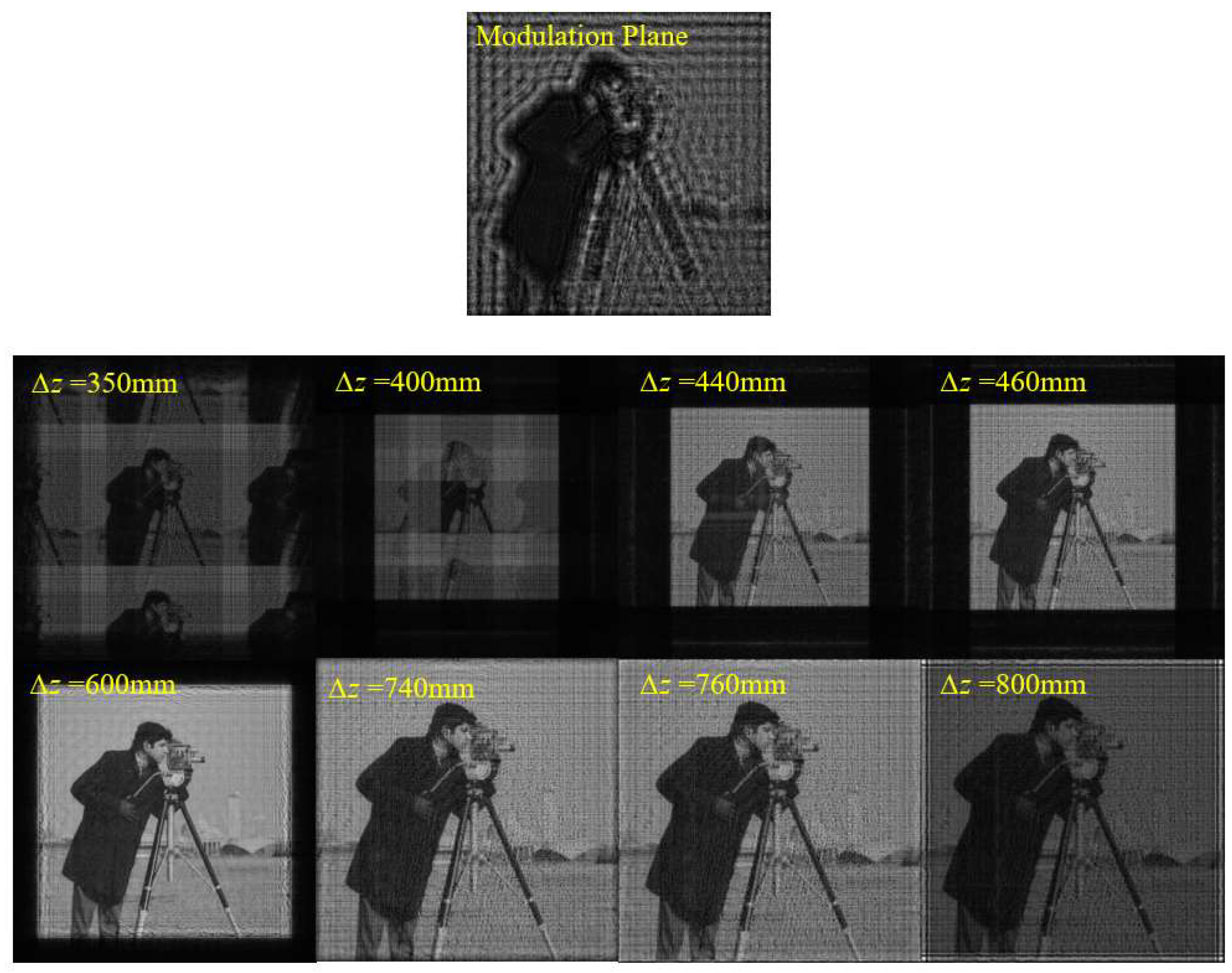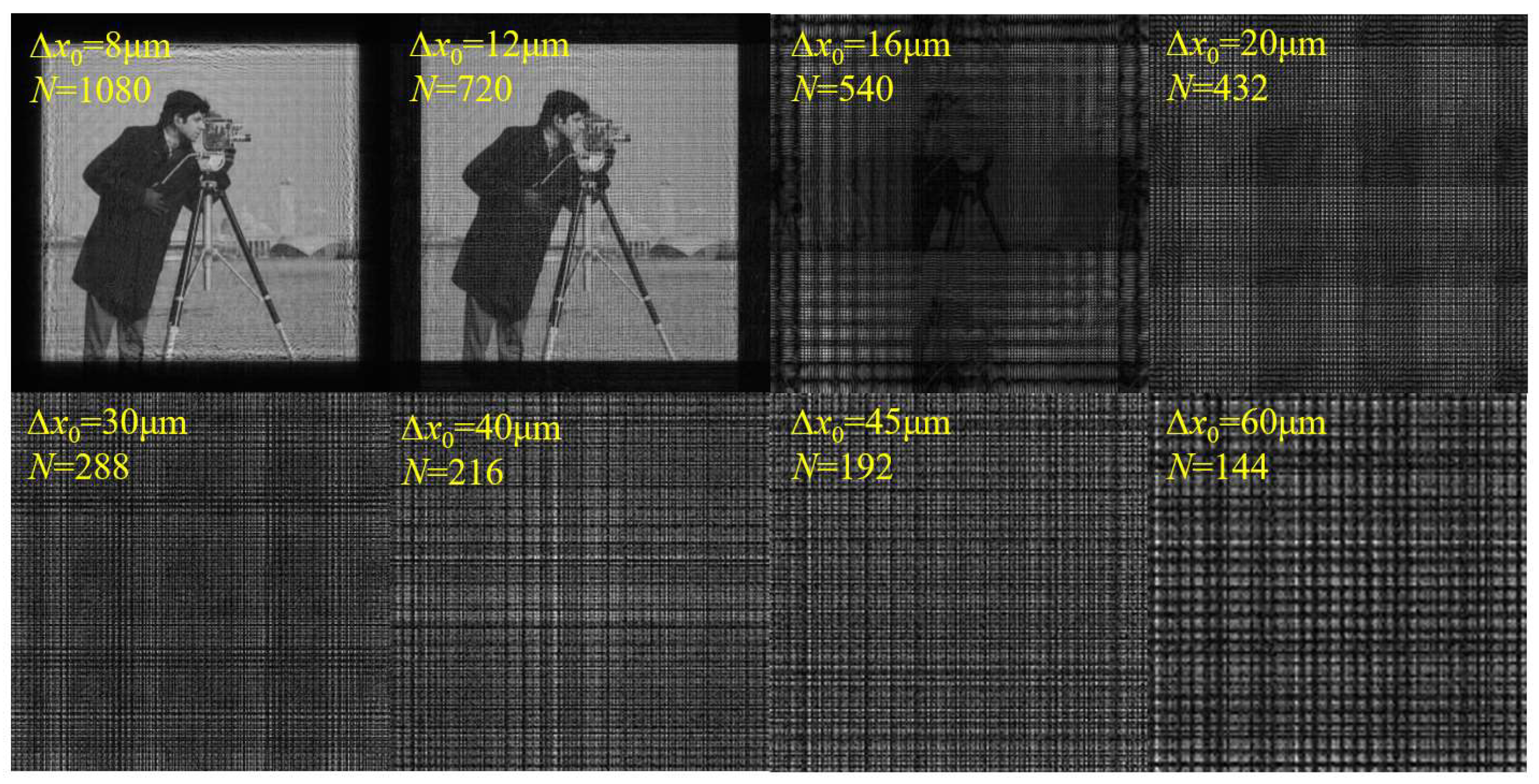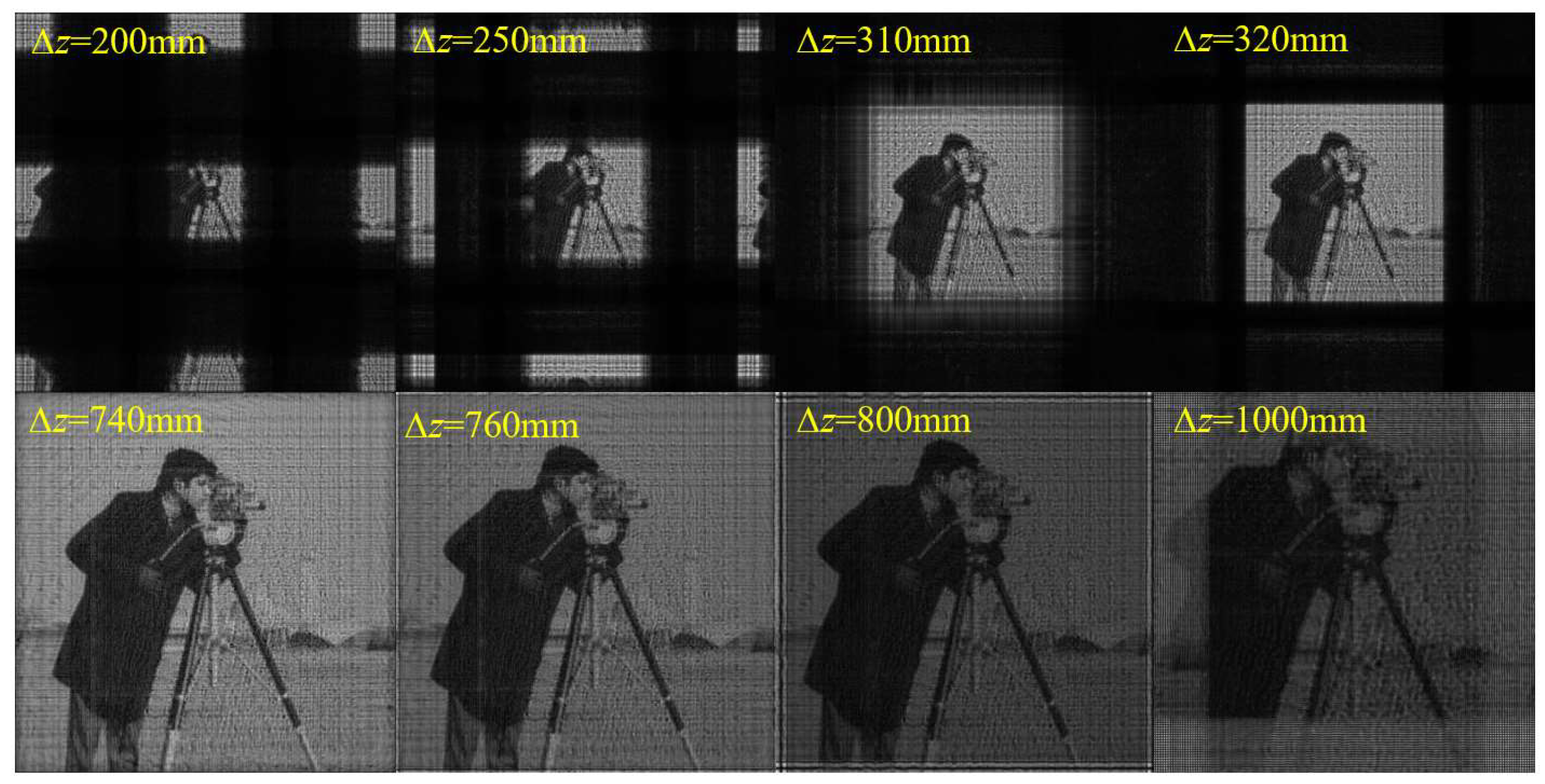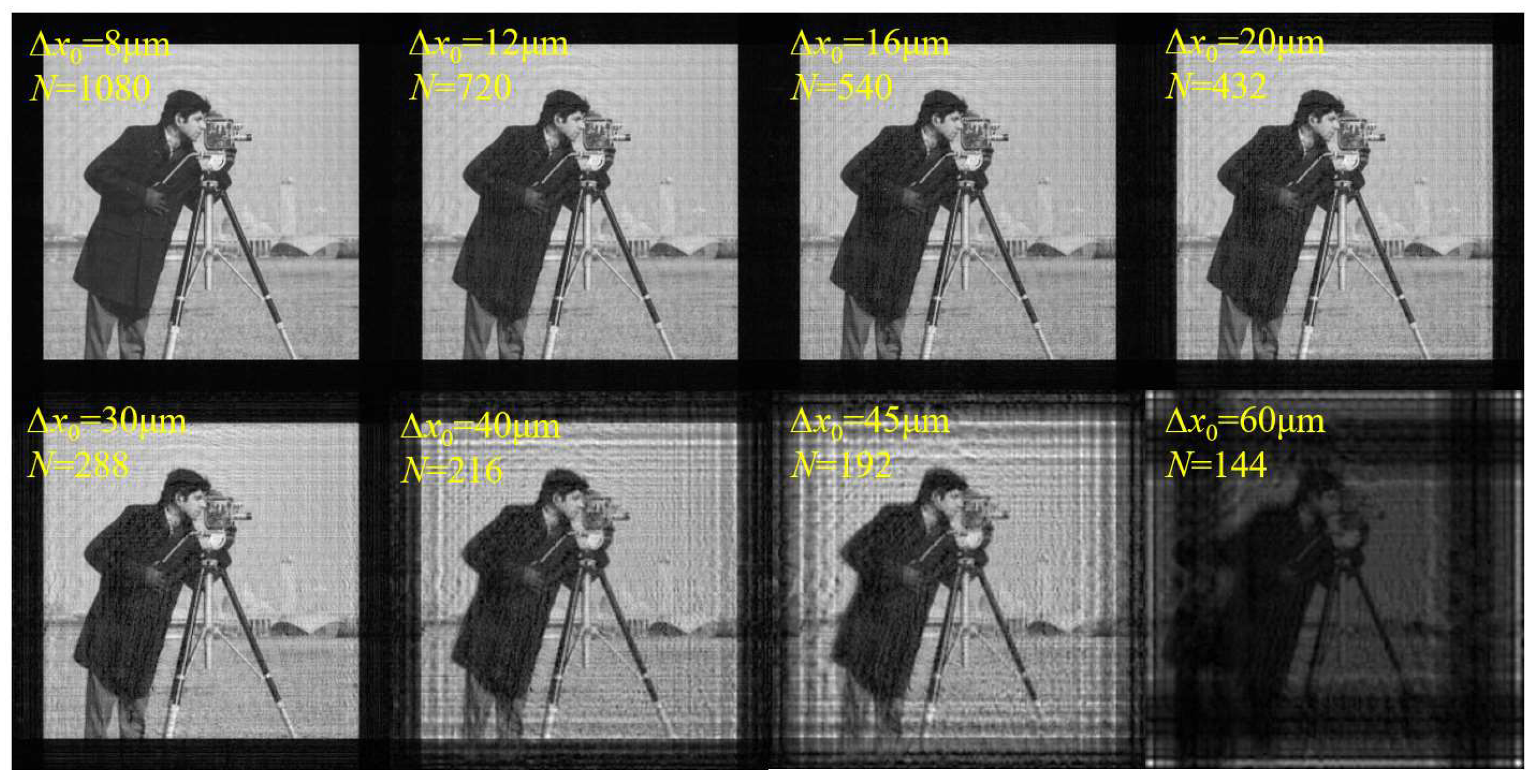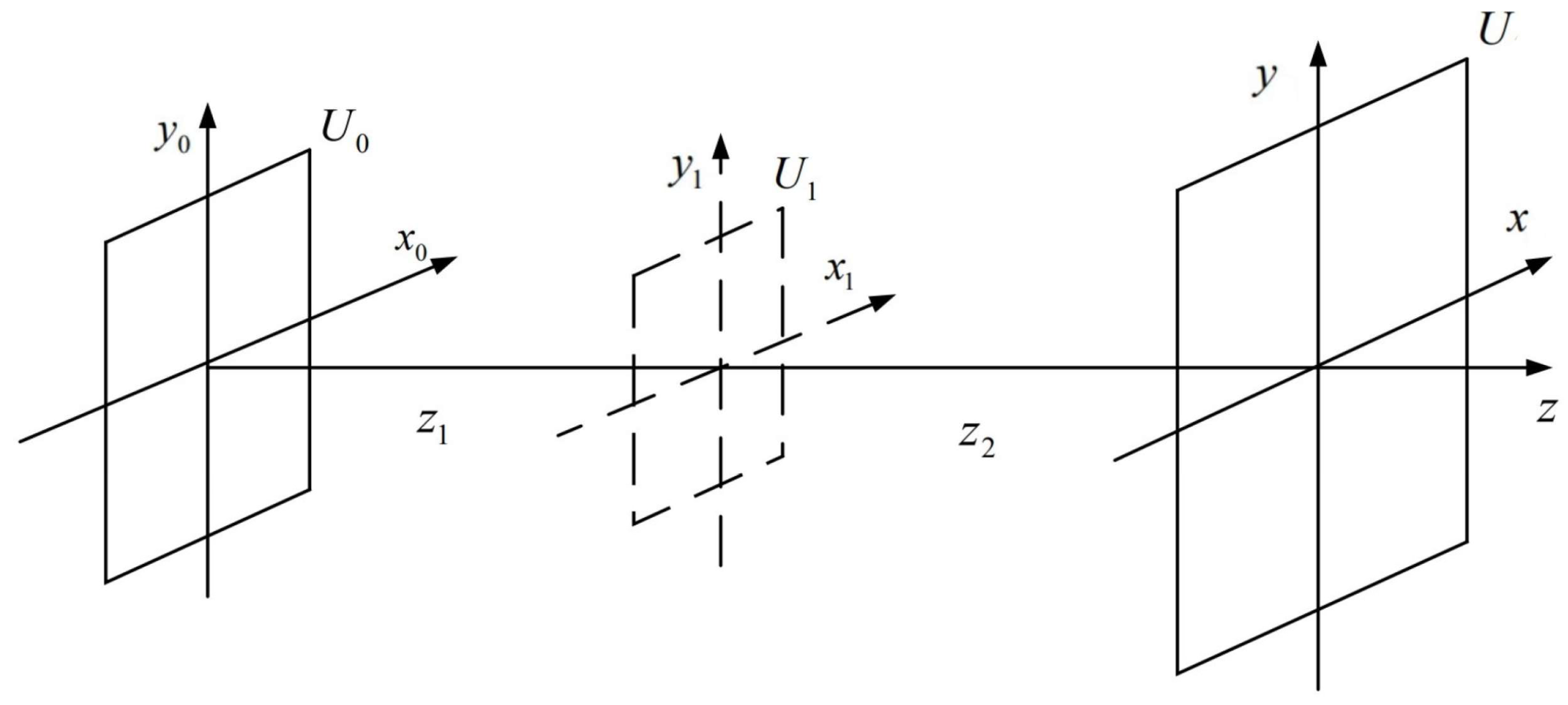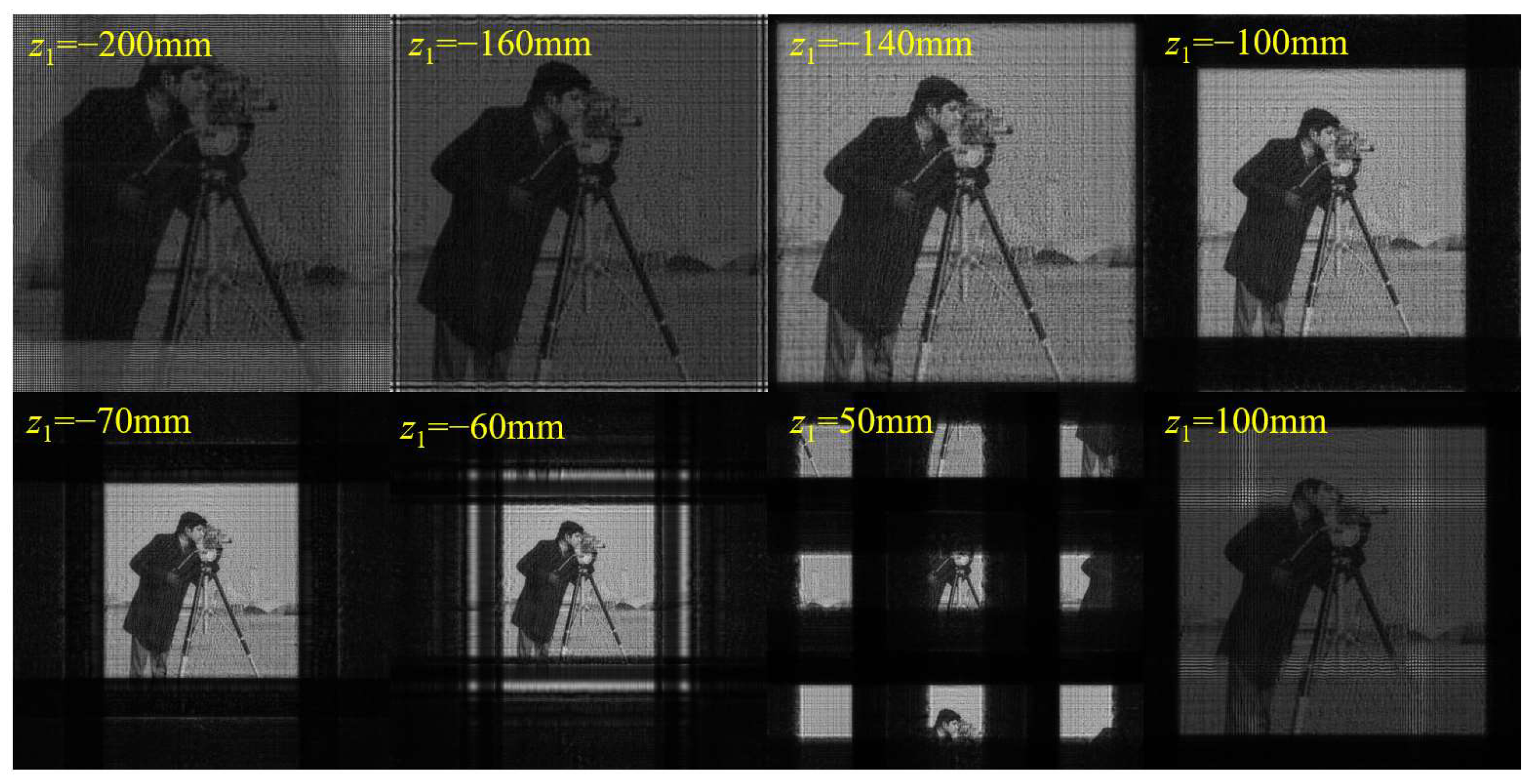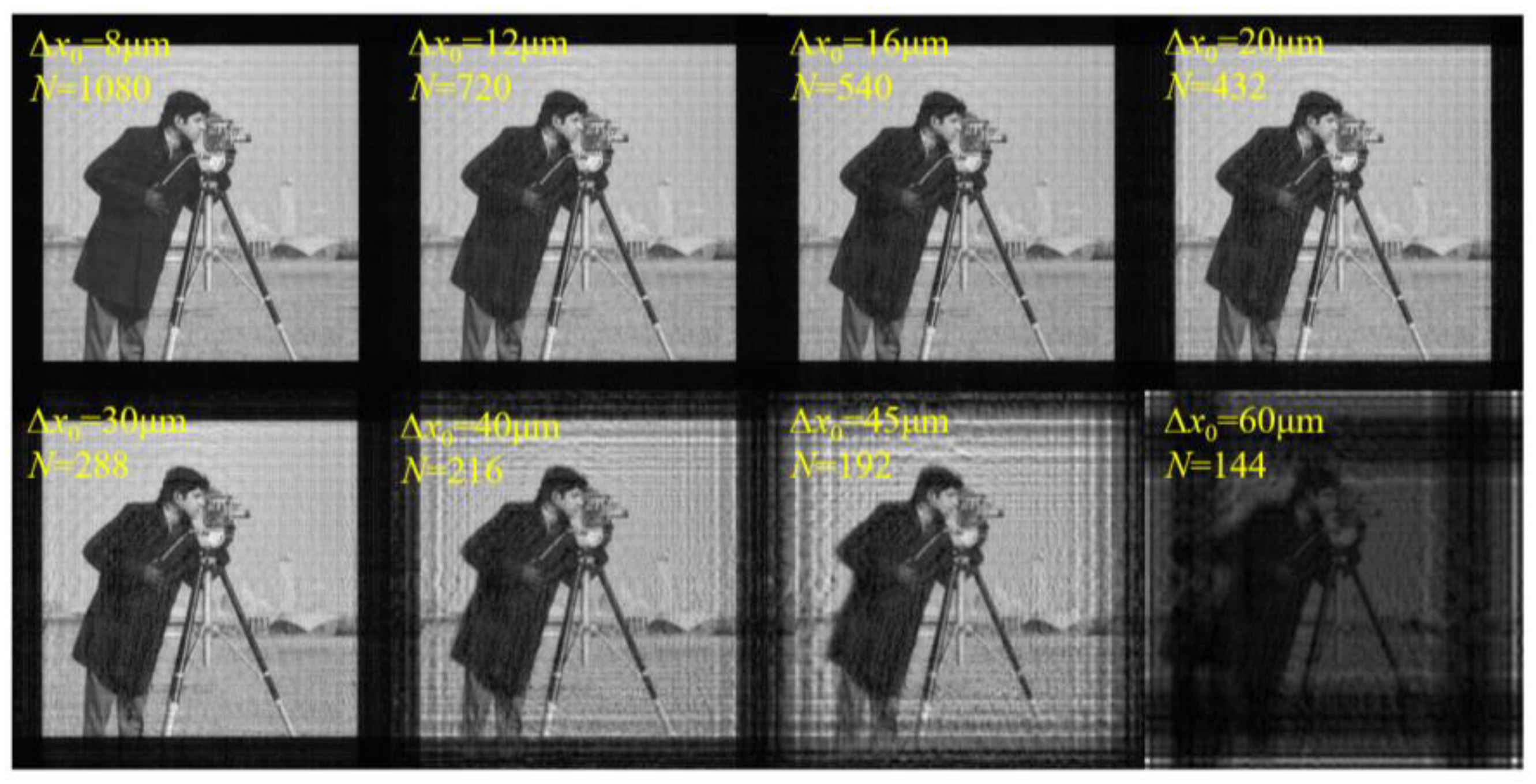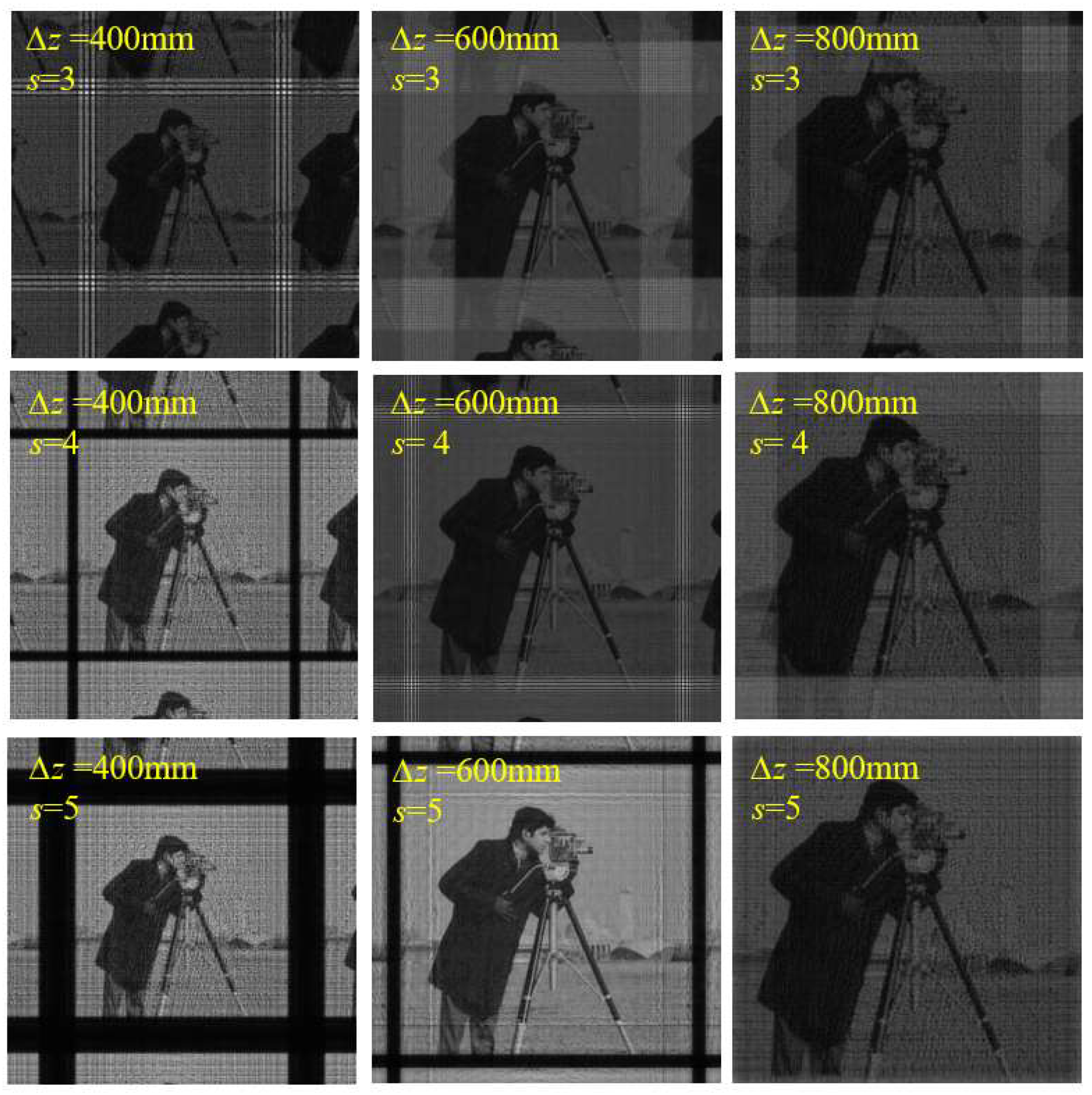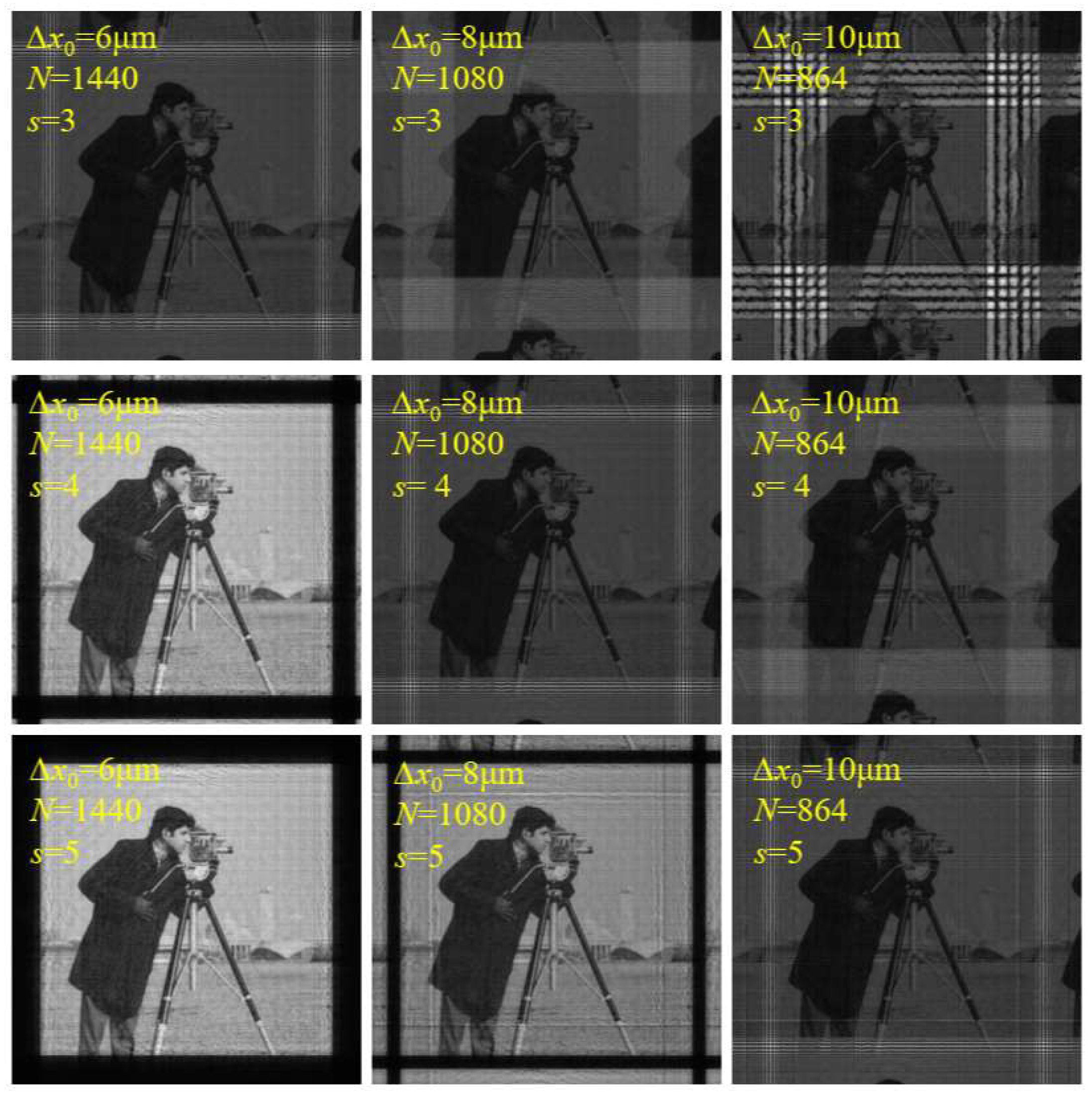Generally, in the diffraction equation, if the phase factors in the Fourier transform term do not satisfy the sampling conditions, the amplitude distribution of the simulated diffraction result will be aliased, and if the phase factors outside the Fourier transform term do not satisfy the sampling conditions, the phase distribution of the simulated diffraction result will be aliased. In display applications, while only the amplitude distribution of the diffracted result is considered, the phase factors outside the Fourier transform term are often ignored. Yet, for a specific diffraction algorithm, it is also necessary to specifically analyze which phase factors are related to the amplitude and which are related to the phase in the target plane before making a choice.
When the initial plane is illuminated by a spherical wave, a quadratic phase factor is introduced into it. The phase factor is related to the distance from the point light source to the initial plane. Generally, the phase factor is similar to the phase factors in the diffraction equation; thus, it can be combined with them to form new phase factors. Then, it is necessary to analyze the sampling conditions of the combined new phase factor. The results obtained by analyzing these phase factors separately and then taking their intersection are inaccurate.
On the basis of the discussions above, we briefly introduction the four algorithms and discuss their sampling conditions separately.
2.1. SFD
The SFD algorithm considers the condition that the center of the initial plane and the center of the diffraction plane are not coaxial and the sampling intervals of the two sampling planes are different. Taking the center point as a relative reference, each sampling point can be written as:
where
p0,
q0,
p, and
q are within [−
N/2,
N/2 − 1] and
N is the number of horizontal (vertical) sampling points. Only the case where the two sampling planes are square is considered here, and the sampling points of the two planes are the same. Then, according to Equation (3), we obtain:
where
Equation (7) contains a convolution operation and can be converted into a Fourier transform operation:
Then, FFT can be used, and the calculation speed will be greatly accelerated. A total of three FFT operations are required. This algorithm has been used in holographic projections without lenses [
16] and 3D holography [
17].
In addition, Tomoyoshi Shimobaba’s group further proposed an improved algorithm ARSS (aliasing reduced Fresnel diffraction with scale and shift operations) to address the drawback of SFD that aliasing will occur with a short diffraction distance [
18]. By introducing a rectangular window, the algorithm eliminates the aliasing phenomenon with a short diffraction distance. They used the ARSS in a virtual converged spherical wave computer-generated holographic system [
19], in which the method of cyclic iteration was used to improve the clarity of the reconstructed hologram. However, in order to facilitate comparison with other algorithms, only sampling conditions of the basic algorithm are analyzed.
SFD determines the scaling factor before deriving the diffraction process, and then extracts the convolution operation, so that FFT can be used for fast calculation.
The quadratic phase factors of
a(
p0,
q0) and
b(
p0,
q0) in Equation (9) are mainly analyzed. Here, in order to keep the simulation conditions consistent with other algorithms, only the case where the centers of the initial plane and diffraction plane are coaxial is considered. The scaling factor is still assumed to be
m. Next, as shown in
Figure 1, we consider the phase factor introduced by the spherical wave for illumination, which will also affect the sampling conditions.
The phase factor introduced by the illumination spherical wave
Pdiv is expressed as:
It should be noted that the spherical wave here is not necessarily a divergent spherical wave illuminated by a point light source. This is only true when r is > 0. When r is < 0, the spherical wave is convergent. When r tends to +∞, the incident light tends to the plane wave. Here, we only analyze the case where r is > 0 or r tends to +∞.
In order to satisfy the sampling theorem, the sampling frequency should be higher than twice the maximum spatial frequency. Generally, the phase frequency is much higher than the amplitude frequency. Therefore, only the phase factor in the diffraction equation is considered. Given that the maximum spatial frequency is located at the edge, where the sampling frequency shall satisfy the sampling theorem, for
a(
p0,
q0), we have:
The analysis of the quadratic phase factor in
b(
p0,
q0) shows that:
Next, further analysis is conducted to observe the results of
{
a(
p0,
q0)},
{
b(
p0,
q0)}, and
{
a(
p0,
q0)}
{
b(
p0,
q0)}. Here, taking ∆
z = 500 mm as an example, the analysis process is shown in
Figure 2.
In
Figure 2, the aliasing phenomenon occurs at the edge of
{
b(
p0,
q0)}, but the final diffraction result is normal, because there is an invalid blank area around
{
a(
p0,
q0)}. In addition, in the process of multiplying
{
b(
p0,
q0)}, the aliased part in
{
b(
p0,
q0)} does not affect the effective area at the center of
{
a(
p0,
q0)}; hence, it does not affect the final result. According to this discussion, the analysis of the quadratic phase factor in
b(
p0,
q0) can be adjusted. It is not necessary to satisfy the sampling conditions at the farthest edge of the field, as long as the sampling conditions are satisfied at the edge of the effective area of
{
a(
p0,
q0)}.
Therefore, we need to calculate the range of the effective area in
{
a(
p0,
q0)}. From the form of
a(
p0,
q0), we can get that
{
a(
p0,
q0)} is actually the propagation result of the initial plane illuminated by a spherical wave of radius
r through the distance ∆
z/(1 −
m), which will scale the size of image by [
r(
m − 1) − ∆
z]/[
r(
m − 1)] times. In addition, after a single FFT calculation, the sampling range is scaled by [
N∆
x02(
m − 1)]/(
λ∆
z) times. Given these two scales, the scale of the range of the effective area relative to the original image should be
N∆
x02[
r(
m − −1) − ∆
z]/(
λr∆
z), according to which we can scale
in the sampling conditions obtained from the analysis of the quadratic phase factor in
b(
p0,
q0) to obtain a new sampling condition. It should be noted here that, in order to ensure that the amplitude of
{
b(
p0,
q0)} does not appear aliasing at the boundary of the effective area,
b(
p0,
q0) is required to satisfy the sampling conditions in the diagonal direction at the corners of the effective area, and its sampling interval is
times of the horizontal or vertical interval. Then, we obtain:
Next, we analyze the phase factor in
{
a(
p0,
q0)}
{
b(
p0,
q0)}.
U(
p0,
q0) and the linear phase factor in
a(
p0,
q0) have little influence on
{
a(
p0,
q0)}; thus, they can be ignored. Then, the phase factor of
a(
p0,
q0) can be regarded as exp{
iπ[(1 −
m)
r + ∆
z](
x02 +
y02)/(
λr∆
z)}, and the phase factor of
{
a(
p0,
q0)} can be calculated as exp{
iπ(
λr∆
z)(
fx2 +
fy2)/[(
m − 1)
r − ∆
z]}. Meanwhile, the phase factor in
{
b(
p0,
q0)} can be calculated as exp{−
iπ
λ∆
z(
fx2 +
fy2)/
m}. Multiplying the two phase factors, we obtain exp{
iπ
λ∆
z(
r/[(
m − 1)
r − ∆
z] − 1/
m)(
fx2 +
fy2)}, which meets the sampling conditions at the boundary of the effective area. Then, we obtain:
Since Equation (13) is more restrictive than Equation (11), the final adjusted sampling conditions are:
Next, we performed simulations to verify this sampling condition for the SFD algorithm. Two verifications were performed. One is to adjust the propagation distance ∆
z with other parameters fixed, and the other is to adjust ∆
x0 and
N with other parameters and initial plane size (
L0 =
N∆
x0) fixed. For the first verification, the simulation parameters are set as shown in
Table 1. According to Equation (15) and the simulation parameters, the sampling condition is satisfied when 450 mm ≤ ∆
z ≤ 750 mm.
Figure 3 shows the amplitude distributions on the diffraction plane with different ∆
z. It can be seen that the calculated sampling range is consistent with the simulation results. There is a hologram on the initial plane. In theory, with the condition of
r = 150 mm given in
Table 1, a clear image in focus will be obtained on the diffraction plane 600 mm behind it. All verifications in this paper use the hologram as the initial plane. When ∆
z decreases to 450 mm, horizontal and vertical bright stripes begin to appear in the middle of the image, and the image brightness starts to decrease. With a further decrease in ∆
z, the phenomenon of aliasing becomes more serious. Multiple images overlap and interlace, and the image brightness lowers. When ∆
z increases to 750 mm, bright stripes parallel to the edges begin to appear around the image, and the image brightness starts to decrease. With the further increase in ∆
z, the aliasing becomes more serious, and the image brightness lowers.
For the second verification, the simulation parameters are set as shown in
Table 2. According to Equation (15) and the simulation parameters, the sampling condition is satisfied when ∆
x0 ≤ 15.086 μm.
Figure 4 shows the amplitude distributions on the diffraction plane with different ∆
x0 and
N. The calculated sampling range is also consistent with the simulation results. When ∆
x0 increases to 15.086 μm, multiple images overlap and interlace, horizontal and vertical bright stripes begin to appear, and the image brightness starts to decrease. With the further increase in ∆
x0, the phenomenon of aliasing becomes more serious, and the image becomes illegible. The results prove that the sampling conditions are correct from another perspective. In addition, this sampling condition is also applicable to the Fresnel–Bluestein algorithm, the mathematical essence of which is similar to that of SFD [
20].
2.2. SASM
In the book
Numerical Simulation of Optical Wave Propagation [
10], the author Jason D. Schmidt mentioned an algorithm, which assumes that both sides are coaxial, and also introduces the scaling factor
m, but uses FFT once less than SFD. The author uses angular spectrum propagation to define this method because its calculation form is similar to the angular spectrum form of the Fresnel diffraction integral. This method still uses a paraxial approximation, so it is not strictly equivalent to the true angular spectrum form.
In order to simplify the derivation process of SASM, the following operators are introduced:
where the operators
Q[
c,
r],
, and
in the equation indicate multiplication by the phase factor, Fourier transform, and inverse Fourier transform, respectively. The scalar forms of the vector symbol are
r = (
x,
y) and
f = (
fx,
fy), representing the spatial coordinate and the frequency domain coordinate, respectively. Next is the derivation of SASM. First, the Fresnel diffraction equation can be written as:
where ∆
z is the diffraction distance and
r0 and
r denote the coordinate vectors at the initial plane and the diffraction plane, respectively. Then, a size scaling factor
m of the diffraction plane relative to the initial plane is introduced, and the identity transformation can be performed:
With Equation (17), we can further obtain:
Finally, the convolution theorem can be used to obtain
U(
r2) as:
In this algorithm, the scaling factor is determined before the diffraction process is derived, and the convolution operation is extracted such that FFT can be used for fast calculations.
This is similar to SFD in essence. The difference is that, for the Fourier transform of b in SFD and h in SASM, SFD calculates the Fourier transform, while SASM directly uses the phase factor of the calculation result. The use of FFT in the calculation process is an important factor influencing the sampling conditions; therefore, there are still differences between them. That is, SASM does not have to satisfy the second sampling condition in Equation (13) of SFD, which is obtained from the analysis of b(p0, q0).
The final sampling conditions are as follows:
Next, we performed simulations to verify these sampling conditions for the SASM algorithm. The two verifications were similar to those of SFD. For the first, the simulation parameters were also set as shown in
Table 1. According to Equation (21) and the simulation parameters, the sampling condition is satisfied when 316 mm ≤ ∆
z ≤ 750 mm.
Figure 5 shows the amplitude distributions of the diffraction plane with different ∆
z. It can be seen that the calculated sampling range is consistent with the simulation results. Within the calculated range, the image is only scaled. Beyond this range, aliasing occurs. When ∆
z is large, the result of SASM is the same as that of SFD. When ∆
z is reduced to 316 mm, the edge parts of the image start to separate from the center part, and the image is divided into nine parts, which is different from the common effect of aliasing containing replications, and is caused by the violation of the Nyquist sampling theorem by the second Fourier transform in Equation (20). With a further decrease in ∆
z, the segmented part becomes larger and farther away from the center.
For the second verification, the simulation parameters were set as shown in
Table 2. According to Equation (21) and the simulation parameters, the sampling condition is satisfied when ∆
x0 ≤ 43.944 μm.
Figure 6 shows the amplitude distributions on the diffraction plane with different ∆
x0 and
N. The calculated sampling range is also consistent with the simulation results. When ∆
x0 increases to 43.944 μm, the edge of the image begins to blur, and the image brightness starts to decrease. With a further increase in ∆
x0, the phenomenon of aliasing becomes more serious; the edge parts of the image separate from the center part evidently such that the image is divided into nine parts and the whole image becomes blurred. It can be seen that the sampling conditions of SASM are not as strict as those of SFD due to the lack of the sampling limit for
b(
p0,
q0).
2.3. DBFT
Figure 7 is the schematic of DBFT.
U0(
x0,
y0) and
U(
x,
y) represent the complex amplitude distribution of light field in the initial plane and the diffraction plane, respectively, while
U1(
x1,
y1) is the complex amplitude distribution of the light field in a virtual intermediate plane that does not physically exist, which is indicated by the dotted lines. The diffraction process of the light field from
U0(
x0,
y0) to
U1(
x1,
y1), and from
U1(
x1,
y1) to
U(
x,
y) is taken into account, such that the size of the diffraction plane can be adjusted by changing the position of the virtual intermediate plane.
The sampling intervals on the three planes are ∆
x0 = ∆
y0 =
L0/
N, ∆
x1 = ∆
y1 =
L1/
N, and ∆
x = ∆
y =
L/
N, where
L represents the sampling range and
N represents the number of sampling points. The sampling range of the frequency domain (
Lu,
Lv) has the following mathematical relation with the spatial domain sampling interval in the discrete Fourier transform (DFT):
Therefore, for the three planes, the following relations can be obtained:
Then, we have the following relation:
The relation between
L0 and
L is:
So far, the derivation of DBFT has been completed. The core idea to solve the sampling problem is as follows: in single FFT, the sampling interval in the spatial domain and that in the frequency domain are reciprocal; hence, the size L is not large enough. However, with double FFTs, a positive proportional relation will be obtained after two reciprocal relations, as shown in Equation (25), which is applicable to the diffraction process.
It is worth noting that the absolute value is used in Equation (25), which indicates that the distance parameter can take a negative value, i.e., the intermediate virtual plane does not have to be between the initial plane and the diffraction plane but can also be placed on the left side of the initial plane or the right side of the diffraction plane. For example, the double sampling Fresnel (DSF) algorithm with similar mathematical essence places the intermediate plane at the point light source of the spherical wave for illumination [
21].
From
U0(
x0,
y0) to
U1(
x1,
y1),
The phase factor outside the Fourier transform term only affects the phase distribution of U1(x1, y1); thus, it is not considered. Only the phase factor exp[(ik/2z1)(x02 + y02)] inside the Fourier transform term is considered. Thus, we obtain the sampling condition |z1| ≥ (∆x02N)/λ.
From
U1(
x1,
y1) to
U(
x,
y),
Similarly, we obtain the sampling condition |z2| ≥ (∆x12N)/λ.
Next, further analysis is conducted. The spherical wave phase factor can be combined with the phase factor in the diffraction equation. In addition, the phase factor of U1(x1, y1) can also be combined with the phase factor in the Fourier transform term in the second step. The phase factor of U1(x1, y1) is composed of two parts, one is the phase factor outside the Fourier transform term, and the other is the phase factor of the new term obtained by the Fourier operation of the part inside the Fourier transform term. The influence of the amplitude term U0(x0, y0) in the Fourier transform term can be ignored; hence, the phase factor of the new term obtained after calculation is exp{−iπr(x12 + y12)/[λz1(r + z1)]}.
In addition, similar to the SFD analysis process, the phase factor inside the Fourier transform term in U(x, y) only has to satisfy the sampling conditions at the boundary of effective area of U1(x1, y1). The calculation shows that the scale of the range of the effective area relative to the original image is N∆x02(r + z1)/(λrz1). Therefore, the sampling conditions of the combined phase factor can be analyzed.
The final sampling conditions can be obtained as
Next, we performed simulations to verify this sampling condition for the DBFT algorithm. The simulation parameters were set as shown in
Table 1. According to Equation (28) and the simulation parameters, the sampling condition is satisfied when −150 mm ≤
z1 ≤ −63 mm for any ∆
z = (
z1 + z2) > 0 mm.
Figure 8 shows the amplitude distributions of the diffraction plane with different
z1. It can be seen that the calculated sampling range is consistent with the simulation results. When
z1 is reduced to −150 mm, bright stripes parallel to the edge begin to appear around the image, and the image brightness starts to decrease. With a further reduction in
z1, the aliasing becomes more serious and the image brightness becomes lower. When
z1 is increased to −63 mm, the edge part of the image starts to separate from the center part, and the image is divided into nine parts. With a further increase in
z1, the segmented part becomes larger and further away from the center. When
z1 exceeds 97 mm, horizontal and vertical bright stripes appear in the middle of the image and the image brightness decreases.
Next, in order to keep the same form with the sampling conditions of other algorithms for easy comparison,
z1 and
z2 in the sampling conditions are expressed in terms of
m and ∆
z according to Equation (25). Here, two cases are considered. One is
z2/
z1 =
m and the other is
z2/
z1 = −
m. For the former, the final sampling condition after conversion is:
For the latter, the final sampling condition after conversion is:
It can be seen that the sampling condition of the latter is better, which is consistent with that of SASM. Therefore, in order to avoid aliasing as much as possible, the virtual intermediate plane should be placed on the left side of the initial plane rather than between the initial plane and the diffraction plane when the algorithm is used for large field of view diffraction calculations. Next, two verifications similar to those of other algorithms were performed. Here, m is fixed, which means that the ratio of z2/z1 is fixed. In addition, z1 is always negative while z2 is always positive.
For the first verification, the simulation parameters were also set as shown in
Table 1. According to Equation (30) and the simulation parameters, the sampling condition is satisfied when 316 mm ≤ ∆
z ≤ 750 mm.
For the second verification, the simulation parameters were set as shown in
Table 2. According to Equation (30) and the simulation parameters, the sampling condition is satisfied when ∆
x0 ≤ 43.944 μm.
It can be seen from
Figure 9 and
Figure 10 that not only are the final sampling conditions of DBFT and SASM consistent, but their verification results with the same parameters are also consistent, which shows that although the overall ideas of the two algorithms are completely different, their mathematical essence is similar.
2.4. MPASM
It can be seen that there are still sampling restrictions for the above three algorithms. If all algorithms are not applicable, the matrix product angular spectrum method (MPASM) can be considered. This algorithm was proposed by Wanli Zhao et al. in 2020 [
14]. In this method, the calculation of the true angular-spectrum form without paraxial approximation based on matrix product is realized.
To get rid of the limitation ∆fx = 1/(N∆x), this algorithm uses the matrix product instead of FFT to calculate the diffraction process. Moreover, the frequency domain range can be adjusted by adjusting the number of frequency domain sampling points to satisfy the sampling conditions. Therefore, there is no sampling limit in theory, but the cost is that the calculation time is increased; furthermore, if the number of points is increased to satisfy the sampling conditions, the calculation time will be further increased.
The diffraction process is calculated using the angular spectrum formula:
where
After replacing FFT with matrix product operation, the diffraction equation can be converted into:
where
where
Kfx0 is the scaling factor of the frequency domain plane sampling interval and
S1 and
S2 are the scaling factors of the sampling points in the frequency domain.
So far, the formula of MPASM has been obtained. This formula can be directly applied using MATLAB. Since FFT is no longer used, the sampling will not be limited by it. The disadvantages are also obvious; the computational complexity of FFT is O(
N2log(
N2)), while that of MPASM is O(2
N2.4) [
14]. When the number of sampling points is more than 300, the computational complexity of MPASM will exceed that of FFT.
For the phase factor within the transfer function:
conditions for satisfying the sampling theorem are as follows:
The maximum frequency is calculated as:
where
S1 =
S2 =
s, which controls the number of sampling points. When
s = 1, Equation (37) expresses the effective sampling range of FFT, and the sampling range decreases with the increase in the diffraction distance. When
s > 1, it means that the number of sampling points is increased, and it can be applied to cases where the diffraction distance is relatively large. However, at the same time, it will lead to an increase in computational complexity. The simulation results are shown in
Figure 11 and
Figure 12. It can be seen that when
s is small, the sampling conditions of the algorithm are relatively strict, and aliasing is easy to occur. With an increase in
s, the sampling condition of the algorithm becomes looser, and the upper limits of ∆
z and ∆
x0 become higher.
The parameters were consistent with the simulation of SFD (
Table 1 and
Table 2).


